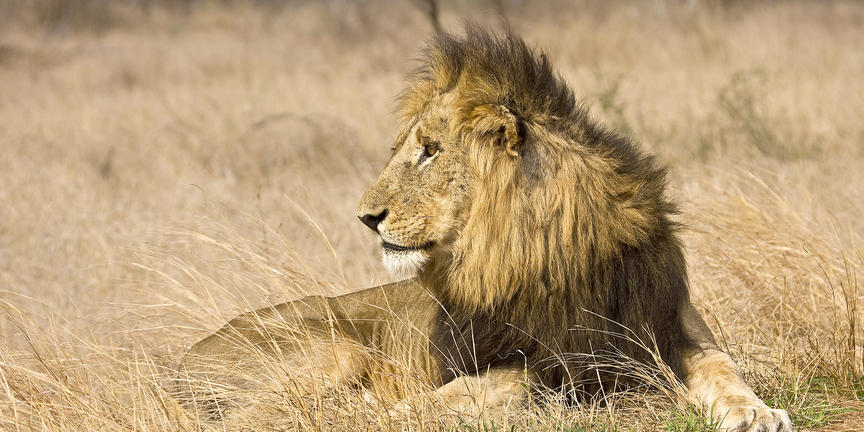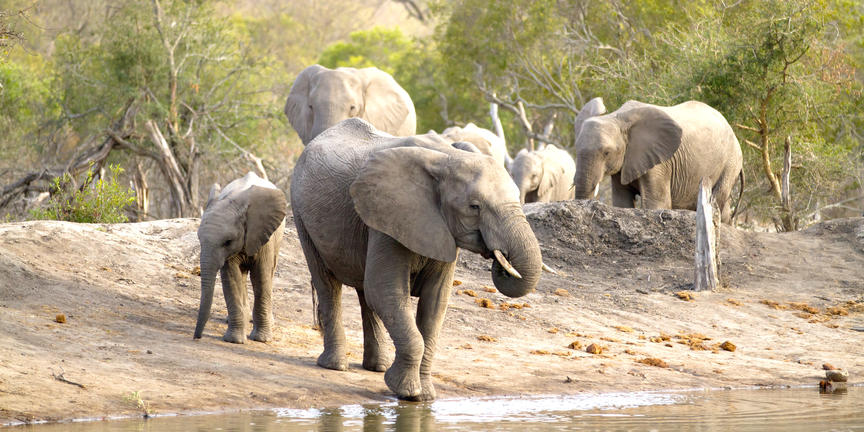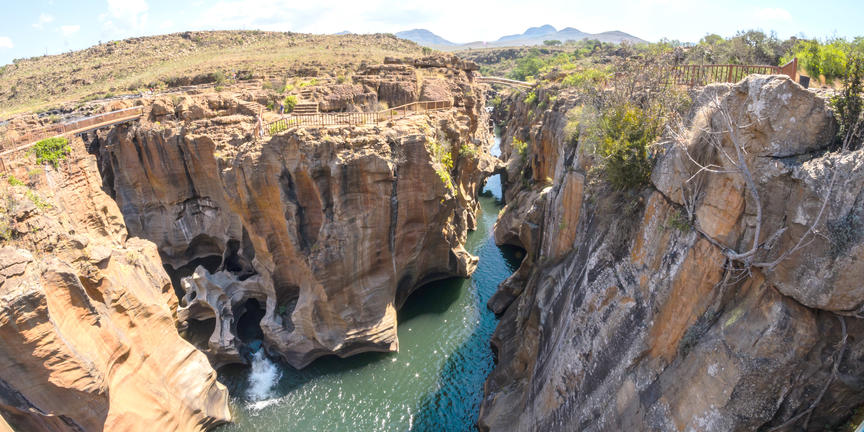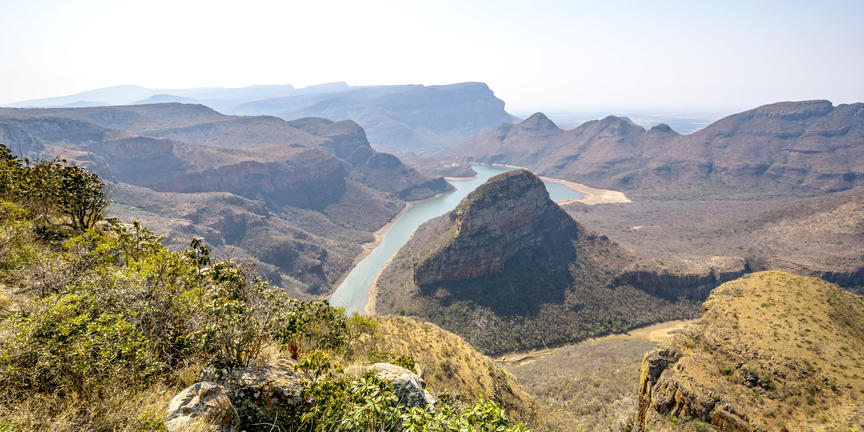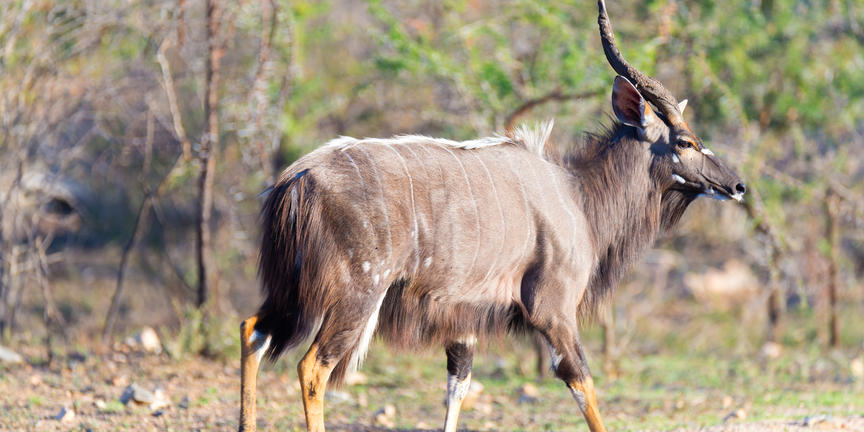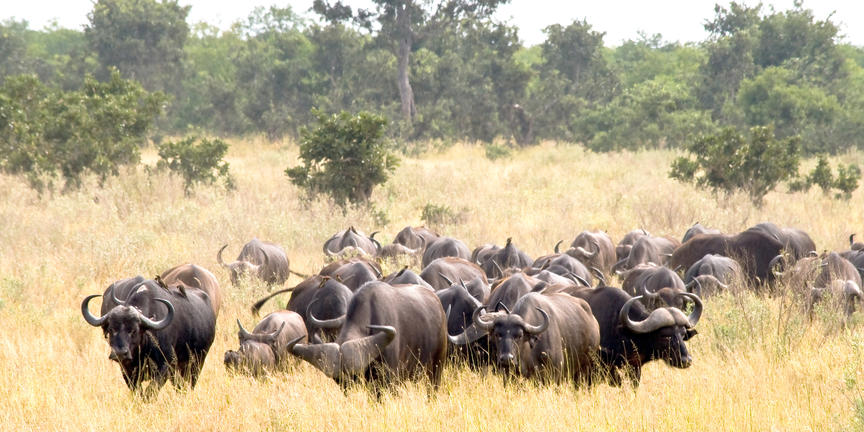Great Glass Elevator - Graskop Gorge Lift
Yup, this is a lift. It takes you down, down, down the sheer cliffs into the Graskop gorge and it’s an hour’s drive from Kruger. Keep your eyes open or you're missing the point. It’s a crazy ride showcasing the best of the Motitsi Waterfall and the Afromontane forests.
You (and about 25 others) will travel down 51 metres. At the bottom you can explore the gorge on a 600m circular trail. The place is decked out with walkways, massive platforms, suspension bridges and elevated boardwalks. If you fancy a bit of a rush, try the Big Swing, which is (spoiler alert) a very, very big swing.
Golden Eye - Pilgrim's Rest
Next up, Pilgrim’s Rest, about 40 minutes drive from Graskop, is a charming little town declared a National Monument in 1986. It’s basically a living memory; a place frozen in time: ‘gold rush’ time. Those crazy, wild-west days in South Africa which began in the late 1800s.
Spend the day gold panning. Imagine you’re Alec “Wheelbarrow” Patterson - the guy credited with finding the stuff here in 1873. He roamed the hills with his wheelbarrow - hence the catchy moniker - and literally stumbled across a fortune. His discovery was the richest known deposit of alluvial gold on the subcontinent.
Underground mining continued at Pilgrim’s Rest until the 1920s, but today the entire town has been restored as a national monument and delightful living museum.
Great Gorge - Blyde River Canyon
And from purest gold to purest green. What a beauty this is. Allegedly the third largest canyon on Earth and the greenest due to its lush subtropical foliage. The canyon carves through its eponymous 260 sq km nature reserve and this magnificent spectacle is easily one of South Africa’s most outstanding natural attractions. It’s also the main reason why the famous route got it’s name, Panorama. All those views over the Klein Drakensberg escarpment really are spectacular.
This splendid gorge has been carved by the Blyde River a thousand metres below your viewpoint. It started taking shape millions of years ago when the Drakensberg escarpment was forming. The ancient supercontinent of Gondwana broke apart and slowly, slowly the canyon came to be.
Christened Blyde by the Dutch in 1844, the official name is Motlatse but most people still use its colonial one. To see it in its full glory simply take any of the numerous hiking trails. One of the most challenging is the Blyde River Canyon Hiking Trail, which crosses half of the reserve and takes several days. Or just drive along the Panorama Route, stop, gawp, take selfies. You’ll want to stop at the most iconic viewpoints: Three Rondavels, God’s Window and Bourke’s Luck Potholes. Let’s look at them in more detail...
Fool's Gold - Bourke's Luck Potholes
These huge stratified potholes mark the start of the Blyde River Canyon. They were named after a gold digger named Tom Bourke, who staked a claim nearby. Poor old Tom, his claim didn’t produce a single flake of gold. Worse still, the hapless chap was right all along and many men found much gold. Except Tom.
The potholes are a series of cylindrical rock sculptures formed after centuries of swirling water where the Treur River meets the Blyde. The eddies are white, yellow and dark brown because of the soil in the water. A series of metal bridges take you right above them and the visitor centre nearby has lots of information about the canyon’s origins and the flora and fauna found here.
You'd do well to put some time aside at Bourke’s Luck to enjoy one of the 5 km trails - the Interpretative Trail and the Bushman Nature Trail. Beautiful, interesting and so very peaceful.
Portly Peaks - Three Rondavels
This striking trio of peaks has starred in many an Instagram shot. They look a bit like beehives and a lot like rondavels - the iconic traditional African hut with its cylindrical walls and a cone-shaped thatched roof. The triplets are sometimes called Three Sisters and even get referred to as the ‘Chiefs Troublesome Wives’ - with the chief being Mapjaneng - the flat-top peak dude.
Whatever you call them, they’re large lumps of rock. Impressive lumps but lumps all the same. Lumps of quartzite and shale offering a view which has been described as one of the finest in South Africa.
Holy Vistas - God's Window
Another frame for a seemingly endless view which seems to stretch to the edge of the universe, God's Window is close to Graskop on the R534. You’ll be at an approximate height of 800 meters here and have a view over the lowveld. It’s name gives you a clue as to how lovely this spot is. You can see rock formations, waterfalls, and the Lebombo Mountains. On a clear day, you can see as far as the Mozambique coastline.
Water Falling - Berlin & Lisbon Falls
Both the Berlin and the Lisbon Falls are close to God’s Window.
The Berlin falls were named by homesick German settlers and they tumble down in a single drop for about 80 metres. The waters below look green and the cliffs look red.
Most impressive during the rainy summer from October to March, Lisbon is the highest waterfall in Mpumalanga. A grand 94 metres and unsurprisingly named after the capital city of Portugal.
Chambers, Music & Treasure - Sudwala Caves
Now these guys are ancient. They’re the oldest dolomite caves in the world. Over 30km long they date back about, oh about 3,000 million years ago. It blows your mind.
The caves are dominated by an enormous chamber called The Amphitheatre which can seat over 500 people. And it does... as a concert hall since the 1970s. The acoustics are excellent and the temperature surprisingly pleasant.
Sudwala Caves is stacked with giant stalactites, stalagmites and flowstones with names like Samson’s Pillar, the Rocket, and the Screaming Monster. Choose your guided tour: the easy one or the tough one known as the Crystal Tour. Clamber 2,000 metres into the cave and finally reach a crystal chamber where you will see aragonite crystals. It’s not for the faint hearted though, as you do have to crawl through tunnels, and some water filled tunnels at that.
About 800 horseshoe bats live here and humans have made their mark, too. Homo habilis, one of the earliest members of the genus Homo, lived in the caves around 1.8 million years ago. An array of well-preserved tools and artefacts are on display near the cave entrance.
Humans have also used these caves as a jolly excellent hiding place and who can blame them? It’s rumoured that President Paul Kruger hid gold here at the end of the Second Boer War - to protect it from the British. This gold is known as the “Kruger Millions” and is estimated to be worth around 500 MILLION U.S. dollars. And guess what? It’s never been found... could be your lucky day.
Jurassic World - Sudwala Dinosaur Park
Yup, there’s a dinosaur park next to the caves. It’s set in a rather lush, subtropical forest garden with a viewing deck overlooking ‘Rainforest Valley’.
With life-size dinosaur models in amongst the giant cycads and ancient cabbages this park attracts plenty of birds and plenty of monkeys too. Real ones.
Look out for models of the local Cape Lion and Cape Quagga - extinct for about a century - as well as ancient plant colonies and even models of dear old Mr. & Mrs. Pless. They’re the beloved million-year-old southern apes who sparked intense debates about the origins of man.
Interesting fact - the models were sculpted by Jan van Zijl who is also responsible for the black wildebeest on the old South African 2c coin.
And Then There Was... Life - Songimvelo Game Reserve
Singimvelo means 'we are conserving nature' in the siSwati language, and boy have they been doing that since forever. This is a game reserve packed with evidence. Evidence of the earliest life forms on the planet. A place where the oldest known single cell form on earth can be found. Here at Songimvelo the 3.5 billion-year-old rocks house such important fossils that the whole region is called the ‘Genesis of Life’.
Deep in the Barberton mountains, Songimvelo is in the south eastern part of Mpumalanga on the Swaziland border. Its 49,000 hectares make it the biggest provincial reserve in the whole of South Africa too. With waterfalls, gorges and the Komati, Msoli and Lomati rivers, it's an incredibly scenic reserve. Early Stone Age artefacts dating back a million years and more than 20 species of large herbivores now call this place home.
Look out for elephant, white rhino and a huge population of buffalo. Also many more animals, including African wildcat, brown hyena, giraffe and hippo to gawk at. Add to that 23 fish species, 50 reptile and amphibians and 330 bird species and we're starting to see some rather special. It’s also an area with the highest recorded plant diversity in Mpumulanga with more than 1440 species identified. Since 1991, at least four species new to science have been collected here, including the only remaining wild population of the Woolly Cycad.
Barberton Outsider Art - Painted Stone Garden
Also in Barberton is the Painted Stone Garden. This was a passion project created in the 1970s and 80s by an ‘outsider’ artist called Nukain Mabuza. Outsider art is used to describe art that has a naïve quality, often produced by people who have not trained as artists or worked within the conventional structures of art production. Mabuza called his work his ‘Garden of Flowers.’ The rocks at the entrance to the town are painted in his style. In its heyday it was a fantastic rock garden with decorated huts and painted hillside boulders. Mabuza took his own life in 1981, but his work inspired the Tony award winning Athol Fugard play “The Painted Rocks at Revolver Creek.”
A River Runs Through It - Lowveld National Botanical Gardens
A garden shaped by the two main rivers that cut across it, the Crocodile and Nels Rivers. It’s 159 rugged, rocky hectares, and home to over 600 indigenous plant species, and a further 2,000 which have been introduced. The garden has one of the largest collections of South African trees, with over a third of the lowveld’s 800 indigenous woody plant species represented here.
Birds love it. Over 243 species having been recorded including African finfoot, emerald spotted wood dove and the nocturnal spotted eagle owl. They have many reptile and amphibians species too including the Mozambique spitting cobra, the fearsome black mamba, spotted bush snakes and twig snake. Butterflies live alongside vervet monkeys, dwarf mongoose and hippopotamus. The hippopotamus stuffs down about 40kg of grass per night and is rarely seen in the day. Probably lying low with belly ache.
Conclusion
And that pretty much sums up Mpumalanga. And yet we haven’t even mentioned Pinnacle Rock, Jock’s View, or the adrenaline hotspot, Hazyview and numerous animal rehabilitation centres including the Maholoholo, which takes injured animals, nurses them back to health and releases them back into the wild. But we have to stop somewhere. You don’t though. Mpumalanga is known as Paradise Country so give it a chunky amount of your holiday time.
